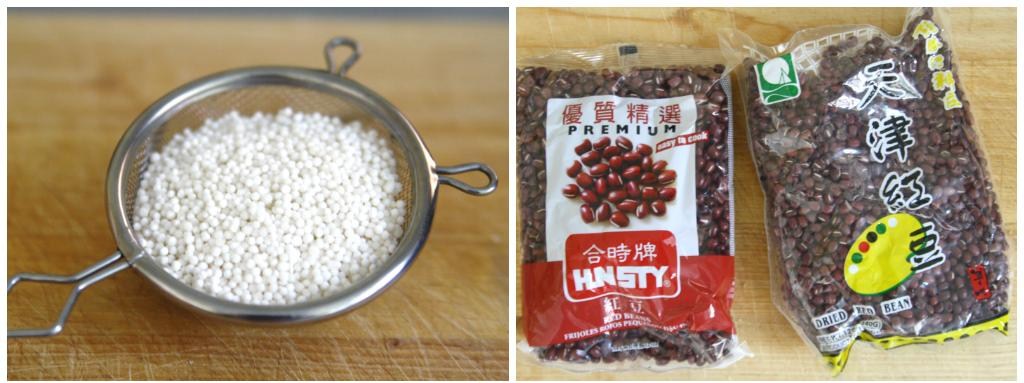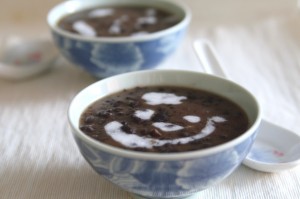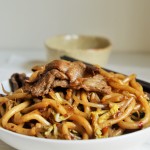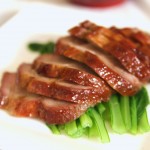Last Updated on April 15, 2022 by Karen
This Chinese Coconut Red Bean Soup with Tapioca Pearls is a fusion of two classic desserts – red bean soup with coconut sago – with double the deliciousness!

In honor of Chinese New Year, I’m sharing with you a Chinese dessert I have enjoyed for years! Traditional Chinese meals often end on a sweet note, usually with fresh fruits and sweet soups, such as ginger and yam soup, black sesame soup, almond milk soup.
Sometimes they are served cold, but I prefer the hot soups because they can really warm you up from inside out, especially in this frigid cold we are experiencing right now!
Are sweet soups eaten all year long?
Yes! If I hadn’t grown up eating sweet soups, I would probably finding it strange to be serving them as desserts. I think the sweet soups are meant to be nourishing and therapeutic, no matter what time of the year it is.
Ginger warms you up, black sesame and almond are good for the skin and hair, and red beans are suitable for upset stomach at least according to Chinese medicine. In the summer, sweet mung bean soups are often served to “cool” you down (if you are into the hot-cold/yin-yang concept).

This Coconut Red Bean Soup with Tapioca Pearls is a fusion of two classics. Classic red bean soup is usually made with red beans, dried orange peel, dried lilies, and lotus seeds. Coconut sago, or tapioca pearls, is another popular sweet soup.
Anything with coconut milk in it can’t go wrong in my opinion, so I combined the two to make my ultimate favorite sweet soup!

What kind of dried red beans can you use for this Chinese Coconut Red Bean Soup?
At my local Asian grocery stores, there are at least two varieties of red beans available. The popular ones are the Chinese red beans from Tianjin and the Japanese azuki beans.
Tianjin beans are smaller in size, duller and brownish in color, and not as starchy as the azuki beans. When cooked, the beans tend to fall apart and the resulting soup has a thinner consistency with the beans settling on the bottom of the bowl. However, they cook up faster, and can be a good choice if the sweet soup involves some ingredients that may thicken up the soup itself (for example, some people like to add mochi or rice dumplings).
For this recipe, I used azuki beans – which are rounder and brighter in color – because the beans tend to stay intact when cooked, unless you are boiling them for a very long time. Another benefit about using azuki beans in sweet soups is that the resulting soups are often thicker in consistency.
It really depends on your preference, and if you don’t know, get them both and experiment with them!

What are tapioca pearls?
Dried white tapioca pearls are popular in Asian desserts. They become translucent when cooked and are pretty flavorless on their own, but add a nice chewy texture to foods and drinks. Don’t confuse them with the black tapioca pearls (large and chewy) which are used in boba teas.
How come the tapioca pearls dissolve or cake up in water?
When working with tapioca pearls, make sure you don’t rinse or soak them before cooking. Also, the water has to be at a rolling boil before you add the tapioca pearls. Otherwise they will cake up in a big lump.
How do you know when the tapioca pearls are cooked through?
You’ll know they are done once they are completely translucent, without any opaque white center.

Hope you enjoy this sweet dessert soup! If you’ve tried this recipe, leave a comment below to let me know what you think!
Chinese Coconut Red Bean Soup with Tapioca Pearls
Ingredients
- 10 cups water divided
- 1/4 cup tapioca pearls
- 2 cups small red beans or Japanese azuki beans, soaked overnight, rinsed, and drained
- Rock sugar to taste (depending on your preferred level of sweetness)
- 1 13.5- oz can coconut milk
Instructions
- In a small saucepan, bring 2 cups of water to a boil. Add tapioca pearls and simmer, uncovered, for 10 minutes. Cover with a lid and remove from heat. The tapioca pearls should plump up and turn translucent in about 10 minutes (if not, let it reboil for 5 minutes and keep it covered again for 10 minutes). Drain the liquid through a sieve and rinse with cold water until water runs clear. Set aside.
- In a large pot, bring the beans and 8 cups of water to a boil over high heat. Reduce the heat to low and let simmer, covered, stirring occasionally. Make sure there is enough water covering the beans at all time; add more boiling water if necessary. Cook for about 1.5 hours, or until the beans are tender and the liquid reduces to a thick consistency.
- Stir in rock sugar and allow to dissolve completely. Stir in tapioca pearls and coconut milk before serving. Serve hot or chilled.
Notes
Like this recipe? Try my other favorite Chinese recipes:
- Chinese Roast Pork Pastry Puffs (Char Siu So)
- Flaky Chinese Scallion Pancakes
- Chinese Barbecued Pork (Char Siu)

















Pingback: Recipes | Pearltrees
This looks amazing! Thanks!!
Hope you like it!
I’m looking for ways to use tapioca, So this sounds great. But I’m not eating sugar right now… How important is it to the recipe?
Hi Angie, the traditional recipe is made with sugar so it’s more like a dessert instead of a savory soup, but feel free to omit sugar and enjoy as is. The coconut milk will provide a natural sweetness. You can also use sugar alternatives such as stevia and monk fruit sweetener.
Karen, thanks for sharing your recipe. I made it for some friends recently and it turned out great! This is such a comforting and nostalgic dessert. I had also added some ginko nuts and dried mandarin peel to the dessert and it was delish! Thanks so much for the inspiration!
Glad you like it Lisa! What a great idea with the addition of gingko nuts and dried orange peel – I’ve got to try that next time!